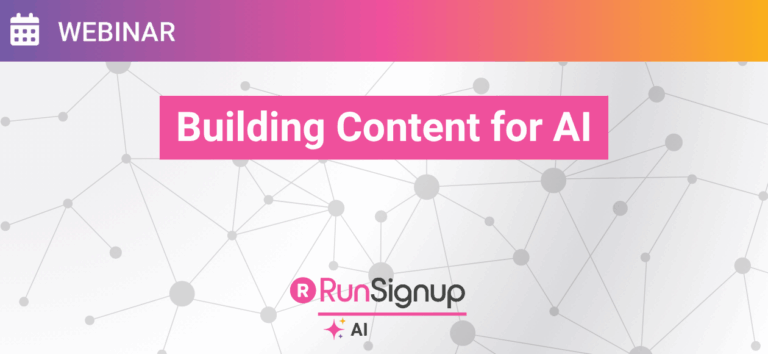Event Information
WHEN
ON DEMAND
Join Director of Marketing Johanna Goode to learn how to build strong content is the foundation of effective AI tools. This session covers how to structure and format your event website copy so that AI chatbots, search tools, and future integrations can better understand and deliver your information.
Summary of Webinar
Overview
This session flips the usual AI script: instead of using AI to write your content, you’ll learn how to write content for AI. You’ll see what AI is pulling from your site, how “GEO” (Generative Engine Optimization) differs from SEO, how to structure pages so AI answers are accurate, why an FAQ matters, and two easy ways to track your growing AI traffic.
Why this matters (AI traffic & search behavior)
AI-driven discovery is rising quickly (e.g., Google AI Overviews, ChatGPT/Gemini queries).
People ask AI “natural language” questions (e.g., “Can I transfer from the 5K to the half?”).
If your site doesn’t clearly answer, AI may guess (hallucinate). Clear, current content reduces wrong answers and support emails.
Content best practices for AI (and people)
GEO vs. SEO—what’s different?
From keywords → to intent. Optimize for the question behind the search, not repeating “5K Philadelphia.”
Write conversationally. Think “How do I…?” / “Where is…?” / “When is…?”
Answer first, then details. Put the direct answer in the first 1–2 sentences under a clear heading.
Cover more questions = earn more surface area
Include multiple, related questions (transfers, packet pickup, pace groups, parking, awards).
Each Q&A block is another entry point for AI and scanners.
Structure pages for scannability
Lead with the essentials (what/when/where/cost).
Use real headings (H1/H2/H3), not just big fonts.
Break into short sections; keep intents separate (Registration vs Race Day vs Results).
Prefer lists & tables for things like price increases and schedules (not images of text).
Multimedia, images & accessibility
Video helps discovery (YouTube is commonly cited by AI).
PDFs are often ignored; prefer on-page text.
Add alt text only when the image conveys real info (leave decorative images blank).
Site health & crawlability
Fast load, mobile-first layout, clean URLs, and a stable site structure help both SEO and GEO.
Make sure the “must knows” (date, location, registration) are always visible and consistent.
Build a high-quality FAQ (your AI backbone)
Use the FAQ component (Website V2) and add at least 5–10 core questions—most events will have more.
Organize by sections (e.g., Registration, Packet Pickup, Race Day, Results & Awards, Policies).
Keep Qs in the user’s language: “How do I transfer to another event?” not “Event transfers.”
Answer directly in the first sentences; add nuance after.
Update FAQs as questions change; once your AI Chatbot is enabled, review its logs and refine answers.
Pro setup tips
One-column layout for readability.
Multiple FAQ components on one page (one per section).
Avoid pasting policy dates everywhere—use dynamic fields where possible to prevent contradictions.
Track your AI footprint (quick & free)
1) See what Google’s AI Overviews cite
Install the “AI Search Impact Analysis” Chrome extension.
Test your key queries (“best 5K in {city},” “{race name} transfer policy”) and see which domains the AI snippet cites.
If you’re missing, compare your content structure/clarity to cited pages and adjust.
2) Monitor AI traffic in GA4 (easy mode)
Use a Looker Studio “AI Traffic” template (prebuilt) connected to your GA4 property.
View AI-driven sessions, landing pages, and sources without custom GA4 gymnastics.
Key takeaways
Write for questions, not keywords. Clear headers + first-sentence answers win.
Structure = signal. Real headings, lists, tables, and sectioned FAQs guide AI (and help readers).
Stay consistent & current. Dynamic dates/prices, no contradictions.
Let data guide updates. Review chatbot logs and AI cite sources; iterate your content.
